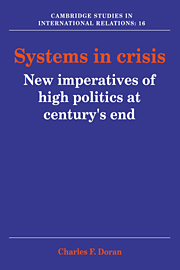Book contents
- Frontmatter
- Contents
- Preface
- Acknowledgments
- Introduction: new perspectives on the causes and management of systems crisis
- Part 1 Dynamics of state power and role: systems structure
- Part 2 Dynamics of major war and systems transformation
- Part 3 Dynamics of general equilibrium and world order
- 6 Prerequisites of world order: international political equilibrium
- 7 World order and systems transformation: guidelines for statecraft
- Part 4 Systems transformation and world order at century's end
- Appendix: Mathematical relations in the power cycle
- References
- Index
7 - World order and systems transformation: guidelines for statecraft
Published online by Cambridge University Press: 08 September 2009
- Frontmatter
- Contents
- Preface
- Acknowledgments
- Introduction: new perspectives on the causes and management of systems crisis
- Part 1 Dynamics of state power and role: systems structure
- Part 2 Dynamics of major war and systems transformation
- Part 3 Dynamics of general equilibrium and world order
- 6 Prerequisites of world order: international political equilibrium
- 7 World order and systems transformation: guidelines for statecraft
- Part 4 Systems transformation and world order at century's end
- Appendix: Mathematical relations in the power cycle
- References
- Index
Summary
IN SEARCH OF A DURABLE CONCEPT OF WORLD ORDER
A central proposition of this study is that major war can be dissociated from systems transformation. We have demonstrated that failure to manage systems transformation properly has led to extensive war. But while systems transformation cannot be avoided, it can and must be made more responsive to administrative control.
To use an analogy, systems transformation is a period in history which is like the traffic situation at a busy intersection. Along normal stretches of the road, drivers are allowed to pass each other and do so without catastrophe according to well-developed “rules of the road” that are akin to the “norms” of the balance of power. But when drivers attempt anything unusual in a busy intersection (e.g., acceleration, deceleration, change of lanes, passing, or taking their eyes off the road), they are inviting accident, major accident. Too much traffic activity is taking place to make clear judgments.
Hence we come to the crux of the problem of maintaining international political order and of coping with structural change. Statesmen must have sufficient vision as well as diplomatic skill so as to constitute a new world order even as the old equilibrium is being undermined by change which cannot be halted.
From the power cycle perspective, world order is a set of variable relations among states that is reasonably compatible with their values and goals and that is constructed on a stable equilibration of power and interests.
Information
- Type
- Chapter
- Information
- Systems in CrisisNew Imperatives of High Politics at Century's End, pp. 166 - 190Publisher: Cambridge University PressPrint publication year: 1991
